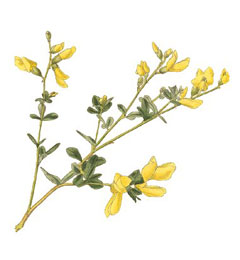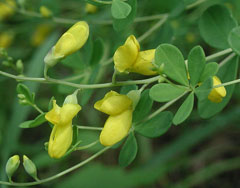 |
|
http://commons.wikimedia.org/wiki/File:Baptisia-tinctoria-Conrad-Loddiges-1822_clean.jpg |
 |
| http://flickr.com/photos/61897811@N00 |
Translate this page:
Summary
Physical Characteristics

 Baptisia tinctoria is a PERENNIAL growing to 0.9 m (3ft) by 0.5 m (1ft 8in).
Baptisia tinctoria is a PERENNIAL growing to 0.9 m (3ft) by 0.5 m (1ft 8in).
See above for USDA hardiness. It is hardy to UK zone 5. It is in leaf from April to October, in flower from July to August, and the seeds ripen from August to October. The species is hermaphrodite (has both male and female organs).
It can fix Nitrogen.
Suitable for: light (sandy) and medium (loamy) soils and prefers well-drained soil. Suitable pH: mildly acid and neutral soils. It cannot grow in the shade. It prefers dry or moist soil.
UK Hardiness Map
US Hardiness Map
Synonyms
Baptisia gibbesii. Podalyria tinctoria. Sophora tinctoria.
Plant Habitats
Cultivated Beds;
Edible Uses
Edible Parts: Leaves Shoots
Edible Uses:
Young shoots - cooked. An asparagus substitute[2, 105, 161, 177]. Some caution is advised, see the notes above on toxicity.
References More on Edible Uses
Medicinal Uses
Plants For A Future can not take any responsibility for any adverse effects from the use of plants. Always seek advice from a professional before using a plant medicinally.
Adaptogen Alterative Antibacterial Antiseptic Astringent Cholagogue Emetic Febrifuge
Homeopathy Purgative Stimulant
Wild indigo was a favourite medicine of the N. American Indians, a decoction of the roots being used as an antiseptic wash for wounds and skin complaints[213, 238]. Modern research has shown that this acrid bitter herb stimulates the immune system[222, 238] and is particularly effective against bacterial infections[238]. Caution is advised in the internal use of this plant, large or frequent doses are potentially harmful[222]. A tea made from the roots is cholagogue, emetic, febrifuge and purgative[4, 21, 46, 165, 222]. The fresh root is also considered to be antiseptic, astringent and laxative[4, 21, 46, 165, 222]. The infusion is used in the treatment of upper respiratory infections such as tonsillitis and pharyngitis, and is also valuable in treating infections of the chest, gastro-intestinal tract and skin[254].The plants antimicrobial and immune-stimulant properties combat lymphatic problems, when used with detoxifying herbs such as Arctium lappa it helps to reduce enlarged lymph nodes[254]. Wild indigo is frequently prescribed, along with Echinacea, in the treatment of chronic viral infections or chronic fatigue syndrome[254]. A decoction of the root soothes sore or infected nipples and infected skin conditions[254]. When used as a mouth wash or gargle the decoction treats mouth ulcers, gum infections and sore throats[254]. The fresh root, including the bark, is used to make a homeopathic medicine[232]. This has a limited range of action, but is used especially in the treatment of certain types of flu[232].
References More on Medicinal Uses
The Bookshop: Edible Plant Books
Our Latest books on Perennial Plants For Food Forests and Permaculture Gardens in paperback or digital formats.

Edible Tropical Plants
Food Forest Plants for Hotter Conditions: 250+ Plants For Tropical Food Forests & Permaculture Gardens.
More

Edible Temperate Plants
Plants for Your Food Forest: 500 Plants for Temperate Food Forests & Permaculture Gardens.
More

More Books
PFAF have eight books available in paperback and digital formats. Browse the shop for more information.
Shop Now
Other Uses
Dye Repellent
This species is related to the tropical plant Indigo (Indigofera tinctoria) and, like that species, contains a blue dyestuff in the leaves[1]. The dyestuff is only contained in very low concentrations, however, and a very large quantity of leaves would be required to obtain reasonable quantities of indigo[169]. A yellow dye can also be obtained from the plant[61]. If the growing plant is harvested and hung up, it is said to repel flies[213].
Special Uses
Food Forest Nitrogen Fixer
References More on Other Uses
Cultivation details
Prefers a deep, rich, well-drained neutral to slightly acid soil in full sun[200, 233]. Grows freely in a loamy soil. Plants are shy flowering in British gardens[200, 233]. Plants have a very deep root system and dislike root disturbance, they should be left alone once they are established[188, 233]. This species has a symbiotic relationship with certain soil bacteria, these bacteria form nodules on the roots and fix atmospheric nitrogen. Some of this nitrogen is utilized by the growing plant but some can also be used by other plants growing nearby[200]. For polyculture design as well as the above-ground architecture (form - tree, shrub etc. and size shown above) information on the habit and root pattern is also useful and given here if available. The plant growth habit is a clumper with limited spread [1-2]. The root pattern is fibrous dividing into a large number of fine roots [1-2]. The root pattern is a tap root similar to a carrot going directly down [1-2].
References Carbon Farming Information and Carbon Sequestration Information
Temperature Converter
Type a value in the Celsius field to convert the value to Fahrenheit:
Fahrenheit:
The PFAF Bookshop
Plants For A Future have a number of books available in paperback and digital form. Book titles include Edible Plants, Edible Perennials, Edible Trees,Edible Shrubs, Woodland Gardening, and Temperate Food Forest Plants. Our new book is Food Forest Plants For Hotter Conditions (Tropical and Sub-Tropical).
Shop Now
Plant Propagation
Seed - best sown as soon as it is ripe in a cold frame[200]. Stored seed should be pre-soaked for 24 hours in warm water and then sown in a cold frame in late winter or early spring. Prick out the seedlings into individual pots as soon as they are large enough to handle and plant them out into their permanent positions in the summer or following spring. Division in spring[188]. Larger divisions can be planted straight into their permanent positions whilst smaller clumps are best potted up and kept in a cold frame until they are growing away well.
Other Names
If available other names are mentioned here
Native Range
NORTHERN AMERICA: Canada, Ontario, United States, Connecticut, Maine (southwest), Massachusetts, Michigan (south), New Hampshire (south), New Jersey, New York (southeast), Ohio (north), Pennsylvania, Rhode Island, Vermont (south), West Virginia, Wisconsin (south), Delaware, Georgia, Kentucky (east), Maryland, North Carolina, South Carolina, Tennessee, Virginia,
Weed Potential
Right plant wrong place. We are currently updating this section.
Please note that a plant may be invasive in one area but may not in your area so it's worth checking.
Conservation Status
IUCN Red List of Threatened Plants Status :

Growth: S = slow M = medium F = fast. Soil: L = light (sandy) M = medium H = heavy (clay). pH: A = acid N = neutral B = basic (alkaline). Shade: F = full shade S = semi-shade N = no shade. Moisture: D = dry M = Moist We = wet Wa = water.
Now available:
Food Forest Plants for Mediterranean Conditions
350+ Perennial Plants For Mediterranean and Drier Food Forests and Permaculture Gardens.
[Paperback and eBook]
This is the third in Plants For A Future's series of plant guides for food forests tailored to
specific climate zones. Following volumes on temperate and tropical ecosystems, this book focuses
on species suited to Mediterranean conditions—regions with hot, dry summers and cool, wet winters,
often facing the added challenge of climate change.
Read More
Expert comment
Author
(L.)Vent.
Botanical References
43200
Links / References
For a list of references used on this page please go here
Readers comment